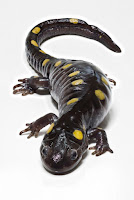Toads & Frogs at a glance
Occupation:
|
Predator
|
Value to Gardener:
|
4/5 - Pest Controller!
|
Danger to Humans:
|
0/5 - None
|
Availability:
|
4/5 – They’ll arrive or you can buy some
|
Quick Intro
Amphibians include three lineages, salamanders, frogs & toads, and caecilians. They all share the characteristic moist skin and mostly four well developed limbs. They are mostly predators that prey on an assortment of insects and small vertebrates (mice and snakes). I will mostly be focusing on Toads and Frogs from the amphibians, as they more common in gardens.
 |
| African Bull Frogs Pyxicephalus adspersus |
So, amphibians have four limbs (some salamanders and caecilians are limbless). All have moist scale less skin that is permeable to both gases and water. The skin contains many mucus glands to keep it moist and thus the skin is termed glandular. The skin allows cutaneous respiration, but this is generally passive. Compounds, such as sodium is actively transported through the skin – this regulates water uptake by terrestrial species. Most breathing is done by the gills (larvae) or lungs (adults). Amphibians can be both terrestrial and aquatic.
Salamaders (Urodeles) have similar body forms as lizards do, with stumpy noses and long tails. The aquatic salamanders are generally limbless. They either live in water bodies (lakes or rivers) or in caves. They catch their prey as frogs do, with a long sticky tongue. They are distributed throughout America, Europe and Asia, but not in Africa or Australia.
 |
| Salamander Photo: Wikipedia, Scott Camazine |
 |
| Frog vs Toad |
Caecillians (Gymnophionans) are strange creatures that look like slimy snakes or huge earthworms. Terrestrial species hide underground and aquatic species are cave-dwelling. Their body form is adapted for burrowing (terrestrial, not necessarily blind) or living underwater (external feathery gills and nearly blind).
 |
| Caecilian Photo: Wikipedia, Dawson |
Habitat
Frogs are mostly water-bound and will live happily in a pond, especially a pond with different water levels, some reeds, that kind of stuff. J
Although toads are terrestrial, they are still confined to moist microclimates (such as thick vegetation or in a pot that gets water daily J).
Diet
This be all little things that crawl, bite and creep at night. The problem is that it includes good and bad insects, but I have seen that my mantis stay clear of Fred (the residential garden toad J).
NB!
 |
| Caution Frogs Ahead! |
So please mind the frogs and toads – the main reason why I was so happy to see Fred moving into the garden – Fred has a new friend now too! J it’s a small 5cm baby toad and seems to be of the same species… I hope Fred isn’t a cannibal, because the baby is still bite-sized…
Fred & Company
Fred is staying in the rose bush, where he/she? has hollowed out a hole to chill in, between the fallen leaves. Fred was very skittish at first, hopping away as if its life depended on it whenever we watered the rose. But now, Fred is quite accustomed to watering J The small one is either in the herbs, with the strawberries or under the beet leaves - I think it is checking out for some prime estate to move into.
Now I think I miss-identified Fred the first time (under my Garden Helpers page), as I assumed that all toads you find in SA (especially in your garden) would be the guttural toad (Bufo gutturalis). But after looking at all the photos on Google today (and my not-so-wonderful animal ID book) and remembering what the toads look like (as I have seen them a bit more recently) - I think that Fred is a Red toad (Schismaderma carens) – although Fred and the baby aren’t as red as some of the pictures J they're more pinkish, especially on the legs. From memory, they have that dorsal ridge running on the side of their body and the two spots on the back like the Red Toad. Also they aren't nearly as patterned as the Guttural Toad. I dunno, what do you say?
 |
| This is Fred, Guttural or Red Toad? Wanted to get a better picture, but Fred's not home J |
 |
| African red toad Schismaderma carens JMK Wikipedia |
 |
| African common or Guttural toad, Amietophrynus gutturalis, Bufo gutturalis (prev), Damien Boilley wikipedia |
The mistaken identity of Fred the Toad J
Update 10 July 2013: Please note - the African guttural toad has been reclassified from previously Bufo gutturalis to Amietophrynus gutturalis. As usual, our University information is outdated, seems this has occurred somewhere in 2006-2007... grrr!
- Update April 2014 -
We have had many baby freds in the garden since. They seem to over-winter here and use the veg garden as a nursery. I found this one in one of our buckets, very happy with its pool of water.
 |
| Red Toad Schismaderma carens |
______________________________________________________________________________
Please share with fellow gardening enthusiasts via the various sharing buttons at the end of posts/pages! Else you can vote for posts through the Google reactions bar at the end of articles. To stay up to date I have provided several reader and social networking platforms with which to subscribe: Twitter, Pinterest, RSS Feed Reader or Email/Follow directly using the Blog Followers widget on the left hand side toolbar. Thank you for reading and please feel free to ask if questions arise - I appreciate comments and ideas too! 😆
_________________________________________________________________________________

